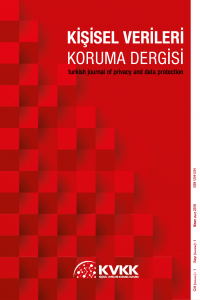Blokzincir Üzerinde Depolanan Verilerin Kişisel Veri Niteliği ve Silinemezlik, Yok Edilemezlik Sorunu
Blokzincir teknolojisi yeniliği, yapısı ve geleneksel veri depolama/aktarma yöntemlerinden farklılıkları sebebiyle önemli tartışmalara konu olmaktadır. Geleneksel sistemlerden farklı olarak birden çok bilgisayarda depolanan bir ağ sistemi sunan blokzincir teknolojisi üzerinde veri depolanması esnasında farklı tekniklerin kullanılması ve özellikle depolanan verilerin daha sonra müdahalesinin teknik altyapı sebebiyle zorlaştırılmış olması kişisel verilerin korunması açısından bazı önemli sorunları beraberinde getirmektedir. Bu çalışmada blokzincir üzerinde depolanan verilerin Kişisel Verileri Koruma Kanunu kapsamında kişisel veri olup olmadığı ve bu niteliği taşıyan veriler açısından yine ilgili kanun kapsamında silme, yok etme, anonim hale getirme işlemlerinin yerine getirilip getirilemeyeceği sorunu özellikle Avrupa Birliği mahkeme kararları ve doktrininde ileri sürülen görüşler ışığında incelenecektir.
Anahtar Kelimeler:
Blokzincir, Kişisel Veri, Silme, Anonimleştirme, KVKK
The Personal Data Status of Data Stored on a Blockchain and the Question of Erasure
Blockchain technology is a subject of ongoing important debate due to its novelty, structure and difference compared to traditional data storing mechanisms. Unlike traditional systems, the fact that the data is stored on multiple nodes connected to a blockchain network by virtue of deployment of different technical infrastructures that is making it difficult to tamper with the date afterwards poses important questions with regards to the protection of personal data. In this study, firstly, the question of whether the data stored on a public-permissionless blockchain can be considered as personal data shall be explored. Following that, secondly, how the processes of erasure and anonymization can be conducted with regards to the data stored on a public-permissionless blockchain shall be examined in light of both the EU case-law and relevant literature.
Keywords:
Blockchain, personal data, erasure, anonymization, GDPR,
___
- Article 29 Data Protection Working Party. (2007). Opinion 4/2007 on the Concept of Personal Data (Opinion No: 01248/07/EN). https://ec.europa.eu/justice/article-29/documentation/opinion-recommendation/files/2007/wp136_en.pdf adresinden 28.10.2019 tarihinde alınmıştır.
- Bashir, I. (2017). Mastering Blockchain. Birmingham/Mumbai.
- Berberich, M. ve Steiner, M. (2016). Blockchain Technology and the GDPR - How to Reconcile Privacy and Distributed Ledgers? European Data Protection Law Review, 2(3), 422-426.
- Commission Nationale de L’Informatique et des Libertés. (2018). Solutions for a responsible use of the blockchain in the context of personal data. https://www.cnil.fr/sites/default/files/atoms/files/blockchain.pdf adresinden 29.10.2019 tarihinde alınmıştır.
- Develioğlu, H. M. (2017). 6698 sayılı Kişisel Verilerin Korunması Kanunu ile Karşılaştırmalı Olarak Avrupa Birliği Genel Veri Koruma Tüzüğü uyarınca Kişisel Verilerin Korunması Hukuku. İstanbul: On İki Levha Yayıncılık.
- Felten, E. (2012, 22 Nisan). “Does Hashing Make Data “Anonymous”? Federal Trade Commission. https://www.ftc.gov/news-events/blogs/techftc/2012/04/does-hashing-make-data-anonymous adresinden 29.10.2019 tarihinde alınmıştır.
- Finck, M. (2017). Blockchains and Data Protection in the European Union. SSRN Electronic Journal. doi:10.2139/ssrn.3080322
- Finck, M. (2019). Blockchain and the General Data Protection Regulation: Can distributed ledgers be squared with European data protection law? (Study No: PE 634.445). Brussels: European Parliament. https://www.europarl.europa.eu/RegData/etudes/STUD/2019/634445/EPRS_STU(2019)634445_EN.pdf adresinden 28.10.2019 tarihinde alınmıştır.
- Güçlütürk, O. G. (2018a). Blockchain: A Trustless Network or a Technologically Disguised Shift of Trust? https://papers.ssrn.com/sol3/papers.cfm?abstract_id=3440044 adresinden 29.10.2019 tarihinde alınmıştır.
- Güçlütürk, O. G. (2018b). The DAO Hack Explained: Unfortunate Take-off of Smart Contracts. Medium. https://medium.com/@ogucluturk/the-dao-hack-explained-unfortunate-take-off-of-smart-contracts-2bd8c8db3562 adresinden 28.10.2019 tarihinde alınmıştır.
- Hon, W. K., Millard, C. ve Walden, I. (2011). Who is Responsible for “Personal Data” in Cloud Computing? The Cloud of Unknowing, Part 2 ( No: 77/2011). Legal Studies Research Paper. Queen Mary University of London.
- Nakamoto, S. (2008). Bitcoin: A Peer-to-Peer Electronic Cash System. https://bitcoin.org/bitcoin.pdf adresinden 20.10.2019 tarihinde alınmıştır.
- Roy, B. ve Meier, W. (2005). Fast Software Encryption. Berlin; London: Springer. http://public.ebookcentral.proquest.com/choice/publicfullrecord.aspx?p=3088651 adresinden 29.10.2019 tarihinde alınmıştır.
- ISSN: 2667-6524
- Yayın Aralığı: Yılda 2 Sayı
- Başlangıç: 2019
- Yayıncı: Kişisel Verileri Koruma Kurumu
Sayıdaki Diğer Makaleler
Aslihan KART, Muammer KETİZMEN
Bankacılık Sektöründe Kişisel Verilerin Korunması ve Müşteri İlişkileri Yönetimi
E-Gizlilik Tüzük Taslağının Son Versiyonu Üzerine Düşünceler
Leyla KESER BERBER, Ayça ATABEY, Melis MERT
Kişisel Verilerin Korunmasının Vergi Mahremiyeti ile Etkileşimi
GDPR Uyumluluk Hazırlığı için bir Araç Olarak Mahremiyet Etki Değerlendirmesi
Bilgin METİN, Sema ERKAN, İdil ATASU, Enes YILMAZ
Veri Sorumlularının Aydınlatma Yükümlülüğü -Avrupa Birliği ve Türk Hukukunda-
